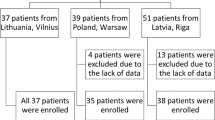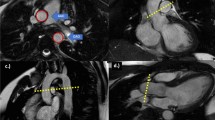Abstract
Regardless of a successful operation, patients with coarctation of aorta (CoAo) are exposed to the risk of hypertension and a propensity to vascular and end-organ damage. The aim of this study is to evaluate the influence of residual aorta stenosis as well as the age at the operation on the parameters of arterial function and structure in patients after CoAo repair. Eighty-five patients after CoAo repair (53 males; mean age: 34.6 ± 10.3 years, mean age at the repair: 10.9 ± 8.2 years) were enrolled in the study. The control group consisted of 30 healthy subjects (18 males; mean age: 33.6 ± 8.2 years). Indices of systemic arterial remodeling [flow-mediated dilatation (FMD), nitroglycerine-mediated vasodilatation (NMD), carotid intima-media thickness (IMT), pulse wave velocity (PWV)] were analyzed in all study patients. In normotensive patients after CoAo repair (47/55%), a significantly increased PWV was observed in comparison to the control group (6.8 ± 1.2 vs. 5.4 ± 0.9 m/s; p = 0.003), with no difference in IMT values (0.53 ± 0.1 vs. 0.51 ± 0.1 mm; p = 0.06). Mean FMD (4.8 ± 2.8 vs. 8.5 ± 2.3%; p = 0.00003) and NMD (11.3 ± 4.6 vs. 19.8 ± 7.2%; p = 0.00001) were lower than in the controls. In patients with a residual aorta stenosis (46/54%), defined as an arm-leg pressure gradient ≥20 mmHg, no differences were found within the scope of both systolic and diastolic blood pressure and of all of the examined vascular parameters. No significant correlations were revealed between the vascular parameters and the gradient across descending aorta as well as the age at the operation. Residual stenosis in the descending aorta does not affect the arterial vasodilatation nor stiffness in patients after CoAo repair. An early surgery does not influence the remodeling of the vessels, which supports the thesis that CoAo is a generalized vascular disease and that even an early operation cannot prevent the progressive and vascular changes and end-organ damage.
Similar content being viewed by others
References
Celermajer DS, Greaves K (2002) Survivors of coarctation repair: fixed but not cured. Heart 88:113–114
Cohen M, Fuster V, Steele PM, Driscol D, McGoon DC (1989) Coarctation of the aorta. Long-term follow up and prediction of outcome after surgical correction. Circulation 80(4A):840–845
Cook SC, Ferketich AK, Raman SV (2009) Myocardial ischaemia in asymptomatic adults with repaired aortic coarctation. Int J Cardiol 133:95–101
Vriend JW, Mulder BJ (2005) Late complications in patients after repair of aortic coarctation; implication for management. Int J Cardiol 101:399–406
Hager A, Kanz S, Kaemmerer H, Hess J (2008) Exercise capacity and exercise hypertension after surgical repair of isolated aortic coarctation. Am J Cardiol 101:1777–1780
de Divitiis M, Rubba P, Calabro R (2005) Arterial hypertension and cardiovascular prognosis after successful repair of aortic coarctation: a clinical model for the study of vascular function. Nutr Metab Cardiovasc Dis 15:382–394
Meyer AA, Joharchi MS, Kundt G, Schuff-Werner P, Steinhoff G, Kienast W (2005) Predicting the risk of early atherosclerotic disease development in children after repair of aortic coarctation. Eur Heart J 26(6):617–622
Swan L, Kraidly M, Vonder Muhll I, Collins P, Gatzoulis MA (2010) Surveillance of cardiovascular risk in the normotensive patient with repaired aortic coarctation. Int J Cardiol 139(3):283–288
O’Sullivan JJ, Derrick G, Darnell R (2002) Prevalence of hypertension in children after early repair of coarctation of the aorta: a cohort study using casual and 24-hour blood pressure measurement. Heart 88:163–166
Oechslin EN (2008) Does a stent cure hypertension? Heart 94:828–829
Gidding SS, Rocchini AP, Moorehead C, Schork MA, Rosenthal A (1985) Increased forearm vascular reactivity in patients with hypertension after repair of coarctation. Circulation 71(3):495–499
Ou P, Celermajer DS, Jolivet O, Buyens F, Herment A, Sidi D, Bonnet D, Mousseaux E (2008) Increased central aortic stiffness and left ventricular mass in normotensive young subjects after successful coarctation repair. Am Heart J 155:187–193
Niwa K, Perloff JK, Bhuta SM, Laks H, Drinkwater DC, Child JS, Miner PD (2001) Structural abnormalities of great arterial walls in congenital heart disease. Circulation 103:393–400
Brili S, Tousoulis D, Antoniades C, Aggeli C, Roubelakis A, Papathanasiu A, Stefanadis C (2005) Evidence of vascular dysfunction in young patients with successfully repaired coarctation of aorta. Atherosclerosis 182:97–103
de Divitiis M, Pilla C, Kattenhorn M, Zadinello M, Donald A, Leeson P, Wallace S, Redington A, Deanfield JE (2001) Vascular dysfunction after repair of coarctation of the aorta. Circulation 104:165–170
Brouwer RM, Erasmus ME, Ebels T, Eijgelaar A (1994) Influence of age on survival, late hypertension, and recoarctation in elective aortic coarctation repair. Including long-term results after elective aortic coarctation repair with a follow-up from 25 to 44 years. J Thorac Cardiovasc Surg 108(3):525–531
Toro-Salazar OH, Steinberger J, Thomas W, Rocchini AP, Carpenter B, Moller JH (2002) Long-term follow-up of patients after operation of the aorta repair. Am J Cardiol 89:541–547
Seirafi PA, Warner KG, Geggel RL, Payne DD, Claveland RJ (1998) Repair of coarctation of the aorta during infancy minimizes the risk of late hypertension. Ann Thorac Surg 66:1378–1382
Vriend JW, Zwinderman AH, de Groot E, Kastelein JJ, Bouma BJ, Mulder BJ (2005) Predictive value of mild, residual descending aortic narrowing for blood pressure and vascular damage in patients after repair of aortic coarctation. Eur Heart J 26:84–90
Mullen MJ (2003) Coarctation of the aorta: do we need surgeons? Heart 89:3–5
Mancia G, De Backer G, Dominiczak A, Cifkova R, Fagard R, Germano G et al (2007) 2007 Guidelines for the management of arterial hypertension: The Task Force for the Management of Arterial Hypertension of the European Society of Hypertension (ESH) and of the European Society of Cardiology (ESC). J Hypertens 25(6):1105–1187
Chen SS, Donald AE, Storry C, Halcox JP, Bonhoeffer P, Deanfield JE (2008) Impact of aortic stenting on peripheral vascular function and daytime systolic blood pressure in adult coarctation. Heart 94:919–924
de Divitiis M, Pilla C, Kattenhorn M, Donald A, Zadinello M, Wallace S, Redington A, Deanfield J (2003) Ambulatory blood pressure, left ventricular mass and conduit artery function late after successful repair of coarctation of the aorta. J Am Coll Cardiol 41:2259–2265
O’Rourke M (1995) Mechanical principles in arterial disease. Hypertension 26:2–9
Ou P, Celermajer DS, Mousseaux E, Giron A, Aggoun Y, Szezepanski I, Sidi D, Bonnet D (2007) Vascular remodeling after “successful” repair of coarctation: impact of aortic arch geometry. J Am Coll Cardiol 49:883–890
Gardiner HM, Celermajer DS, Sorensen KE, Georgakopoulos D, Robinson J, Thomas O, Deanfield JE (1994) Arterial reactivity is significantly impaired in normotensive young adults after successful repair of aortic coarctation in childhood. Circulation 89(4):1745–1750
Swan L, Ashrafian H, Gatzoulis MA (2002) Repair of coarctation: a higher goal? Lancet 359:977–978
Heger M, Willfort A, Neunteufl T, Rosenhek R, Gabriel H, Wollenek G, Wimmer M, Maurer G, Baumgartner H (2005) Vascular dysfunction after coarctation repair is related to the age at surgery. Int J Cardiol 99:295–299
Guenthard J, Wyler F (1995) Exercise-induced hypertension in the arms due to impaired arterial reactivity after successful corarctation resection. Am J Cardiol 75:814–817
Vriend JW, de Groot E, Mulder BJ (2005) Limited effect of early repair on carotid arterial wall stiffness in adult post-coarctectomy patients: in response to article. Int J Cardiol 100:335–336
Maruyama Y (2009) Aging-related arterial-cardiac interaction in Japanese men. Heart Vessels 24(6):406–412
Song BG, Park JB, Cho SJ, Lee SY, Kim JH, Choi SM, Park JH, Park YH, Choi JO, Lee SC, Park SW (2009) Pulse wave velocity is more closely associated with cardiovascular risk than augmentation index in the relatively low-risk population. Heart Vessels 24(6):413–418
Vriend JW, van Montfrans GA, Romkes HH, Vliegen HW, Veen G, Tijssen JG, Mulder BJ (2004) Relation between exercise-induced hypertension and sustained hypertension in adult patients after successful repair of aortic coarctation. J Hypertens 22:501–509
Daniels SR (2001) Repair of coarctation of the aorta and hypertension: does age matter? Lancet 358(9276):89
Vogt M, Kühn A, Baumgartner D, Baumgartner C, Busch R, Kostolny M, Hess J (2005) Impaired elastic properties of the ascending aorta in newborns before and early after successful coarctation repair: proof of a systemic vascular disease of the prestenotic arteries? Circulation 111:3269–3273
Brili S, Dernellis J, Aggeli C, Pitsavos C, Hatzos C, Stefanadis C, Toutouzas P (1998) Aortic elastic properties in patients with repaired coarctation of aorta. Am J Cardiol 82:1140–1143
Kasprzak JD, Płońska M, Drożdż J (2006) Clinical aspects of assessment of endothelial function. Pharmacol Rep 58:33–49
Author information
Authors and Affiliations
Corresponding author
Rights and permissions
About this article
Cite this article
Trojnarska, O., Mizia-Stec, K., Gabriel, M. et al. Parameters of arterial function and structure in adult patients after coarctation repair. Heart Vessels 26, 414–420 (2011). https://doi.org/10.1007/s00380-010-0063-7
Received:
Accepted:
Published:
Issue Date:
DOI: https://doi.org/10.1007/s00380-010-0063-7




